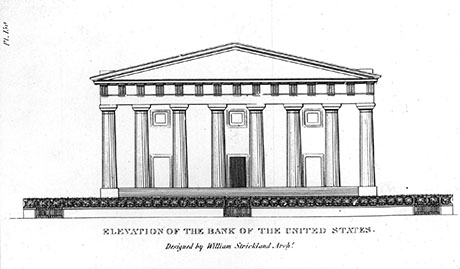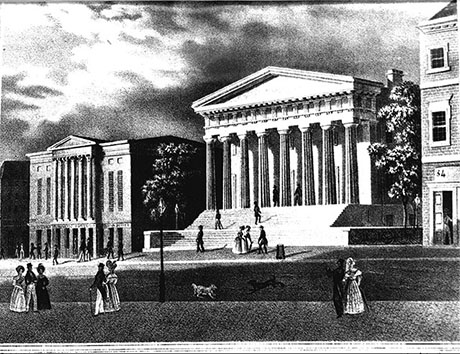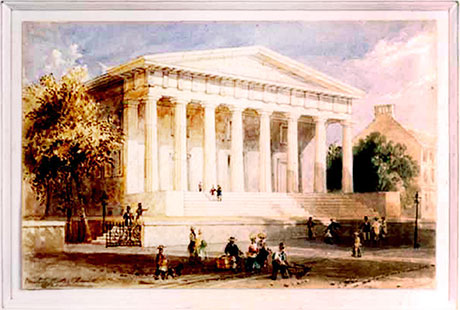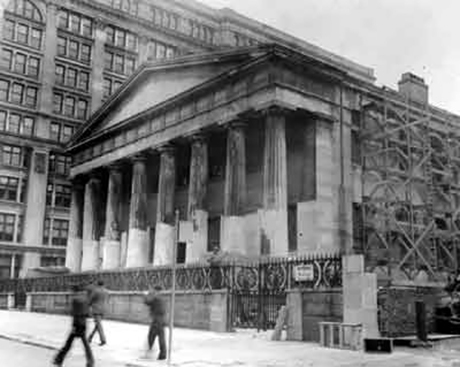| In
1844 William Strickland warned Collector Judge Blythe that "the whole
of the interior as well as the exterior required a thorough cleansing
and repair, particularly in the items of carpentry, masonry, painting
& glazing... The marble columns and architraves of the principle
business room required scrubbing with pumice stone, to remove the dust
of the years..."
|
| | Stone
deterioration on the Bank triggered stone repair in the early 1920’s
when some loose stone was removed from the columns. The stone
deterioration was considered severe enough for the federal government
to request from the Obelisk Waterproofing Company of New York and the
Avron Company of Philadelphia estimates for waterproofing the entire
exterior of the structure. The Obelisk Company gained notoriety for
applying hot paraffin wax on Cleopatra's Needle in 1885 hence the
company’s name. Paraffin has a low melting point, which during hot days
causes dust and particulates to adhere to the surface. Photographs from
1940 show the building covered with black deposits, which might be
explained by the hot wax treatment that the Obelisk Company might have applied.
In
1923, Edward Crane, consulting architect, reported that several pieces
of marble had fallen off, especially from the columns. He agreed that
the building should be cleaned, repointed, and waterproofed. The use of
a waterproofing compound “could do no harm and might prove a real
preservative." For cleaning, he recommended that soap and water should
be used with "a good stiff brush.”
| | In
May 1942 the exterior marble was cleaned and waterproofed, but no
records were found describing the cleansers, tools, or methods used.
Photographs show that the columns and the ashlar of the south facade
were cleaned from the bottom up, with the northern elevation being done
at about the same time in a similar pattern. The east and west facades
were cleaned in sections starting at the southern and northern ends and
working towards the middle.
From
1964-1973, the bank underwent a series of alterations and in 1975, was
reopened as a Portrait Gallery. In 1994, in response to observed stone
failure, a preliminary
assessment of the exterior masonry and characterization and analysis of
the stone was initiated by the National Park Service (INHP) and the
Architectural Conservation Laboratory of the Graduate Program in
Historic Preservation at the University of Pennsylvania. This led to
temporary protection and emergency stabilization of critical areas of
the entablature for public safety and laboratory testing of potential
consolidation methods. Historically there has been periodic dimensional
loss of the marble through spalling on the columns and along the
entablature. Additionally, in unsheltered areas of the ashlar walls,
many stones display a deep pattern of loss through contour scaling of
the stone faces.
Only
small-scale repairs were conducted in the 1980's and 1990’s. From 1983
to the present, several fragments of marble had
fallen off and were adhered back in place with epoxies and other
methods. To prepare the areas the damaged stone was cut away to insure
a good key.
In
1999 following these initial studies, a multi-phased conservation plan
was developed by the ACL and the National park Service and initiated
with the preparation of a detailed computer-based survey of the
exterior masonry conditions and the compilation of a history of past
repairs and treatments to the building. |
| |  | | Elevation Drawing, William Strickland, 1821 |
| 
| | United States Bank, J. C. Wild Lithograph, 1838 |
|  | | United States Bank, Bartlett Watercolor, 1836 |
|  | | South Elevation, National Park Service, 1942 |
|
|
|
|





